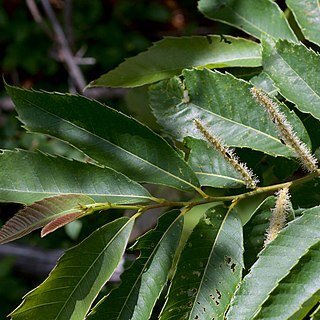A medium sized tree. It grows 6-15 m high. The trunk is 10-50 cm across. The bark is grey-brown and smooth but cracks into flat plates. The leaves are 13-20 cm long by 4-7.5 cm wide. The are narrowly long or sword shaped with many straight parallel side veins. These have teeth at the ends. The leaf stalks are short and nearly hairless. The leaves are yellow-green above and paler underneath. There can be fine white hairs underneath. The flowers are very small and white. There are many male flowers in catkins 5-20 cm long. There are a few female flowers 5 mm long at the base of smaller catkins. The fruit are 2.5-3 cm across. The burs are very spiny. They split open. They contain one round nut which is dark brown and edible.


